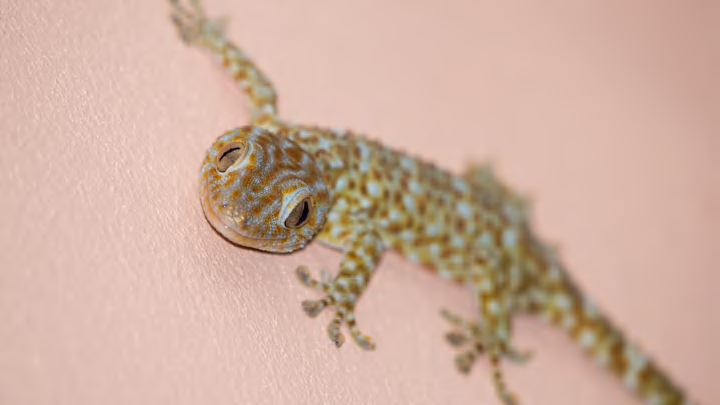Humans frequently adapt technology found in nature to create our own inventions—a concept called biomimicry. After all, sometimes the best tech is right in front of us, thanks to millions of years of evolution. Here are 10 modern inventions humans modeled after plants and animals.
1. VELCRO

Created in the 1940s by Swiss engineer George de Mestral, VELCRO is one of the best-known examples of biomimicry. While hiking, de Mestral noticed that the hook-like structure of burdock burrs allowed the seed pods to stick to his dog’s fur. He decided to explore the potential of creating a clothing fastener using the same technology.
In 1955, de Mestral filed a patent for a “hook and loop” fastener and called it VELCRO, a portmanteau of the French words for velvet (velours) and hook (crochet).
2. Self-Cleaning Paint

Lotus plants are known for their aquatic beauty and as a symbol of longevity in some cultures, but you probably didn’t know that they’re also superhydrophobic. The surface of the lotus plant’s leaves repels dirt and water so well that this self-cleaning quality was dubbed the “lotus effect” in 1977.
In 1999, the German building company Sto released an outdoor paint called Lotusan. When dried, the paint’s microtexture mimics the surface of the lotus leaf to repel moisture and dirt from exteriors.
3. Camouflage

Humans adopted camouflage—a survival tactic for species ranging from the chameleon to the polar bear—as our own defense mechanism, most notably in the military and for hunters.
Camouflage works due to its ability to hide the contour, or outline, of the body, because the human eye has a limited capacity to distinguish color patterns from far away.
4. Solar Panels

While both solar panels and plant leaves harvest energy from the sun, a team at Princeton University took biomimicry in solar panels a step further by adding folds to solar cells. The folds mimic the natural creases found in leaves, channeling more light into the cell. The researchers claimed in 2015 that the leaf-like cells generated 47 percent more electricity than those without folds.
5. Adhesive Climbing Gear

Gecko toes have the unique ability to adhere to most surfaces, including smooth glass. In 2014, a team at Stanford University scaled up the sticky structures found in tokay gecko toes to create a gecko-inspired climbing device. A human test subject was able to “walk” up a glass wall by wearing adhesive pads on his hands and feet.
6. Bullet Trains

The Shinkansen Bullet Train in Japan is known for its aerodynamic shape that decreases the amount of sound the train makes while entering and exiting tunnels at speeds of 150 to 200 mph. The trains were modeled on the long, narrow beak of the kingfisher, a bird that hunts fish by diving into bodies of water with little to no splash. The shape of the train also allows it to travel 10 percent faster with about 15 percent less electricity.
7. Airplanes

While modern airplane design has evolved far beyond the practices of birds, the first designs used what little info humans had about flight—which they obtained by studying birds in the sky.
In the design of their first piloted aircraft, called the Flyer, the Wright brothers mimicked how air increases lift as its flows over the curve of birds’ wings. Birds can also “warp” their wings to remain aloft and streamline their flight. Orville and Wilbur Wright engineered the aircraft so that a portion of its wings “warped” back and forth to produce the same effect.
8. Wetsuits

Unlike whales, beavers don’t have layers of blubber to keep them warm when they dive into chilly water. Instead, their thick fur traps air among the individual hairs, keeping the mammals warm and dry. In 2016, a team of engineers at MIT sought to mimic this quality in a wetsuit covered with rubber “hairs,” specifically designed for watersports athletes like surfers. Just like beavers, the athletes would be kept warm by air trapped on the exterior of the suit.
9. Self-Cooling Architecture

Is the termite a pest or a muse? It depends on who you ask. While many people view termites as unwanted houseguests, at least one architect is looking to the ingenious self-cooling designs of termite mounds for inspiration.
Zimbabwean architect Mick Pearce observed a termite mound on a golf course and noted its shape and ventilation seemed ideally suited to the environment. He incorporated the termite mound design into buildings in Harare, Zimbabwe, and Melbourne, Australia. In each structure, cool air near the ground is channeled upward and hot air at the top of the building is emitted through chimneys.
10. Needles

If you’re afraid of getting your annual flu shot, you might take comfort in a super-tiny needle inspired by the anatomy of the mosquito. The insect's proboscis can quickly penetrate its target’s skin, often without the subject even knowing it’s there (an anesthetic substance in their saliva also helps make their bite less painful). This ability was the inspiration for creating microneedles designed to minimize pain.
